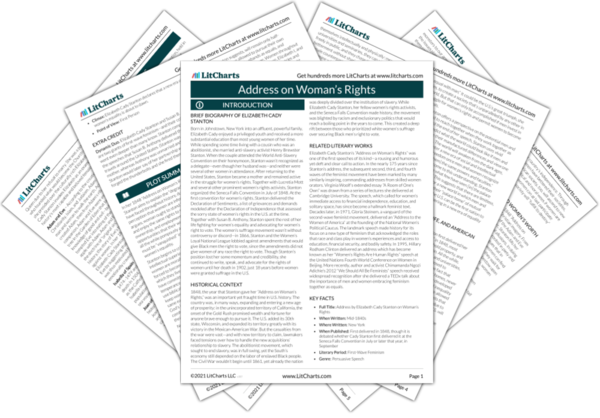Brief Biography of Elizabeth Cady Stanton
Born in Johnstown, New York into an affluent, powerful family, Elizabeth Cady enjoyed a privileged youth and received a more substantial education than most young women of her time. While spending some time living with a cousin who was an abolitionist, she married anti-slavery activist Henry Brewster Stanton. When the couple attended the World Anti-Slavery Convention on their honeymoon, Stanton wasn’t recognized as a delegate—even though her husband was—and neither were several other women in attendance. After returning to the United States, Stanton became a mother and remained active in the struggle for women’s rights. Together with Lucretia Mott and several other prominent women’s rights activists, Stanton organized the Seneca Falls Convention in July of 1848. At the first convention for women’s rights, Stanton delivered the Declaration of Sentiments, a list of grievances and demands modeled after the Declaration of Independence that assessed the sorry state of women’s rights in the U.S. at the time. Together with Susan B. Anthony, Stanton spent the rest of her life fighting for women’s equality and advocating for women’s right to vote. The women’s suffrage movement wasn’t without controversy or discord—in 1866, Stanton and the Women’s Loyal National League lobbied against amendments that would give Black men the right to vote, since the amendments did not give women of any race the right to vote. Though Stanton’s position lost her some momentum and credibility, she continued to write, speak, and advocate for the rights of women until her death in 1902, just 18 years before women were granted suffrage in the U.S.
Historical Context of Address on Woman’s Rights
1848, the year that Stanton gave her “Address on Woman’s Rights,” was an important yet fraught time in U.S. history. The country was, in many ways, expanding and entering a new age of prosperity: in the unincorporated territory of California, the onset of the Gold Rush promised wealth and fortune for anyone brave enough to pursue it. The U.S. added its 30th state, Wisconsin, and expanded its territory greatly with its victory in the Mexican-American War. But the casualties from the war were vast—and with new territory to claim, lawmakers faced tensions over how to handle the new acquisitions’ relationship to slavery. The abolitionist movement, which sought to end slavery, was in full swing, yet the South’s economy still depended on the labor of enslaved Black people. The Civil War wouldn’t begin until 1861, yet already the nation was deeply divided over the institution of slavery. While Elizabeth Cady Stanton, her fellow women’s rights activists, and the Seneca Falls Convention made history, the movement was blighted by racism and exclusionary politics that would reach a boiling point in the years to come. This created a deep rift between those who prioritized white women’s suffrage over securing Black men’s right to vote.
Other Books Related to Address on Woman’s Rights
Elizabeth Cady Stanton’s “Address on Woman’s Rights” was one of the first speeches of its kind—a rousing and humorous yet deft and clear call to action. In the nearly 175 years since Stanton’s address, the subsequent second, third, and fourth waves of the feminist movement have been marked by many similarly inspiring, commanding addresses from skilled women orators. Virginia Woolf’s extended essay “A Room of One’s Own” was drawn from a series of lectures she delivered at Cambridge University. The speech, which called for women’s immediate access to financial independence, education, and solitary space, has since become a hallmark feminist text. Decades later, in 1971, Gloria Steinem, a vanguard of the second-wave feminist movement, delivered an “Address to the Women of America” at the founding of the National Women’s Political Caucus. The landmark speech made history for its focus on a new type of feminism that acknowledged the roles that race and class play in women’s experiences and access to education, financial security, and bodily safety. In 1995, Hillary Rodham Clinton delivered an address which has become known as her “Women’s Rights Are Human Rights” speech at the United Nations Fourth World Conference on Women in Beijing. More recently, author and activist Chimamanda Ngozi Adichie’s 2012 “We Should All Be Feminists” speech received widespread recognition after she delivered a TEDx talk about the importance of men and women embracing feminism together as equals.
Key Facts about Address on Woman’s Rights
-
Full Title: Address by Elizabeth Cady Stanton on Woman’s Rights
-
When Written: Mid-1840s
-
Where Written: New York
-
When Published: First delivered in 1848, though it is debated whether Cady Stanton first delivered it at the Seneca Falls Convention in July or later that year, in September
-
Literary Period: First-Wave Feminism
-
Genre: Persuasive Speech
-
Climax: Elizabeth Cady Stanton declares that a new era of women’s equality is about to dawn.
-
Point of View: First Person
Extra Credit for Address on Woman’s Rights
